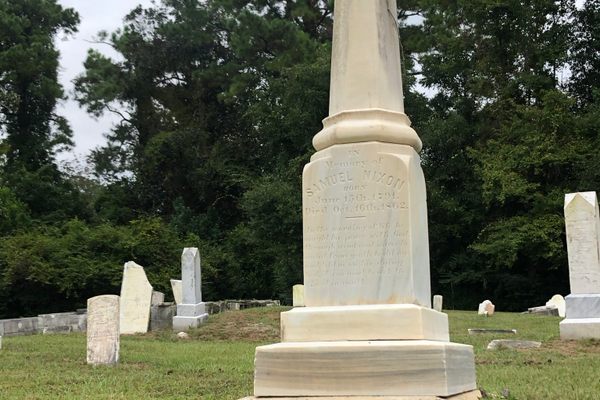About
There’s a parking lot at 1440 Forest Avenue on Staten Island that’s surrounded by a 7-11, Sherwin-Williams, Liberty Tax, and trash that might blow in your face if you’re not careful. It’s also covering a historically Black cemetery, deeded in 1850, illegally seized in 1954, and paved over in the 1960s. It had been the Cherry Lane Cemetery. Now, it's the 1440 Forest Avenue Shopping Plaza.
The cemetery was the final resting place of men, women, babies, children, and the last person born into slavery on Staten Island, Benjamin Prine, who passed away aged 99. Their bodies were never moved.
Cherry Lane Cemetery (also known as the Colored Cemetery and the Old Slaves' Burying Ground) was owned by a board comprising the descendants of men and women who worshipped at the Second Asbury African Methodist Episcopal Church and were buried within its grounds. The church was torn down by vandals in the 1880s and the wood carted away for fencing. But the cemetery remained.
Burials at Cherry Lane were marked by homemade crosses that were stolen and headstones that were bashed apart. Eventually Cherry Lane Cemetery no longer resembled a cemetery. But by the time of its final burial, around 1916, there were up to 1,000 people interred there.
Cemeteries are tax-exempt, though since the city claimed it wasn't a cemetery, they assessed a tax bill of over $11,000. Also, the cemetery had been zoned for commercial use, at least since 1916, when the first zoning maps became available. The board didn't know about any of this.
Enter Edward Menden. Perhaps because he was a Staten Island native, or real estate attorney, or VP of the Staten Island Historical Society—or a combination of all three—he knew there was a plot of land on Forest Avenue up for grabs. And during the post-war development boom, even a simple plot of land on Staten Island could turn a huge profit.
Enter Sidelle Mann, Edward’s sister. Possibly for tax reasons, Edward didn’t pursue the property outright, but in 1954 had Sidelle file a lawsuit against the owners of the cemetery—alive and dead—charging that they were not the legal owners of the cemetery because there was no cemetery.
Investigators hired by Edward and Sidelle interviewed those who lived by the cemetery. They claimed they never saw any burials. That’s because no burials had taken place in more than 40 years. But it was still a cemetery.
No headstones were there because the families either couldn’t afford them, or the ones that had been there were vandalized and stolen. Maps dating from 1874-1954 show a space marked “cemetery” in that precise location. And below the surface lay the dead.
The board retained John Braisted as an attorney. The Braisteds had been on Staten Island since its earliest days as a Dutch colony, and had been in the legal field for nearly as long. However, they still lost. In 1956 the court ruled that there was no cemetery and gave Sidelle the go-ahead to buy the land. The same day she bought it, she sold it to her brother, Edward, for $100. Also in 1956, Edward’s wife Marjorie held a fundraiser for the United Negro College Fund.
In 1962, Edward and Marjorie died in a plane crash. Because they had no children, Sidelle once again became owner of the property, though this time she sold it to her cousin, Max Menden, a car salesman, for $75,000. That’s close to $1 million dollars. It became a Shell station. Gas pumps were drilled into the ground, the bodies still there. As there was no cemetery, according to the courts, there were no bodies to move.
In 1981, the estate of Max Menden sold the property to the Angiuli family, who turned it into the strip mall it is today. In the 1980s, Staten Island Borough Historian, Richard Dickenson, asked the Angiulis to build a memorial on the grounds naming the interred. (Of the possible 1,000 names, 50 are known.)
The Angiulis wouldn’t allow a monument. The compromise was a plaque that mentioned the cemetery, to be put in a First National Bank on the premises. It was placed in the bank lobby in 1991, underneath a sign advertising CD rates. It read: “1850-1953. John W. & Tabita [sic] Blake conveyed this site to Second Asbury A.M.E. Church of Staten Island which established nearby The Cherry Lane A.M.E. Cemetery. Tablet donated by the Anguili Family.”
The bank has since switched hands, Richard Dickenson has passed away, and the property was sold in 2005 for $2.5 million. The plaque is long gone.
However, what’s left of the bodies is still underground.
Related Tags
Community Contributors
Added By
Published
May 16, 2023






















